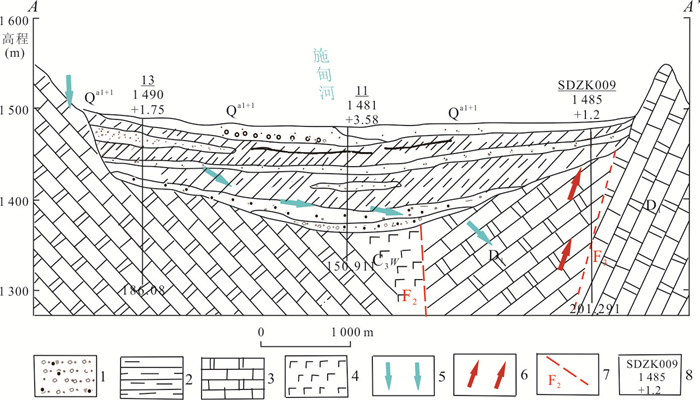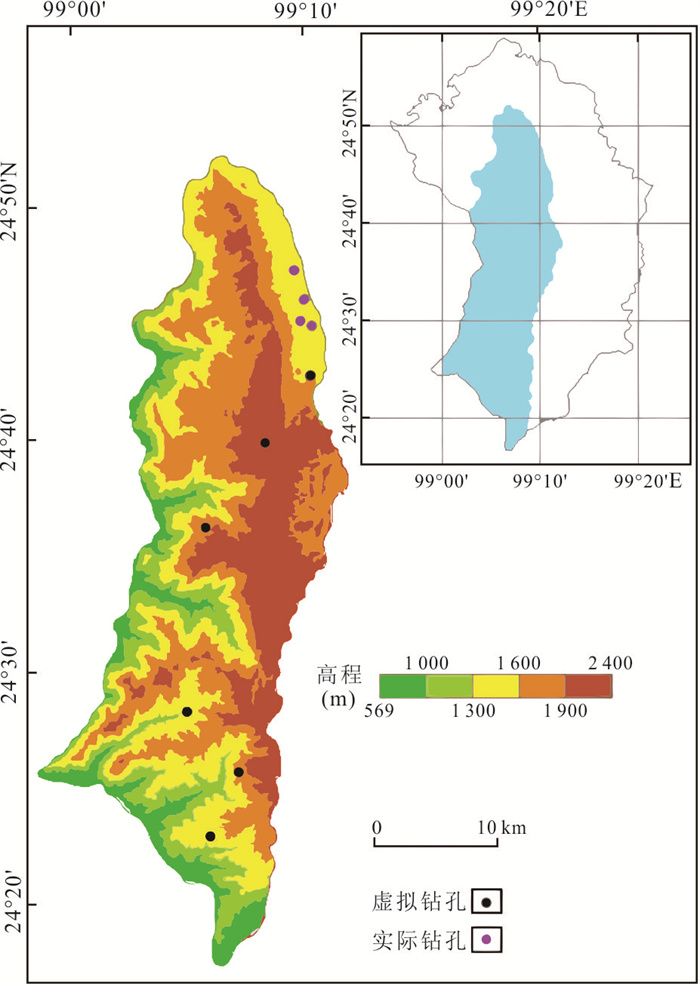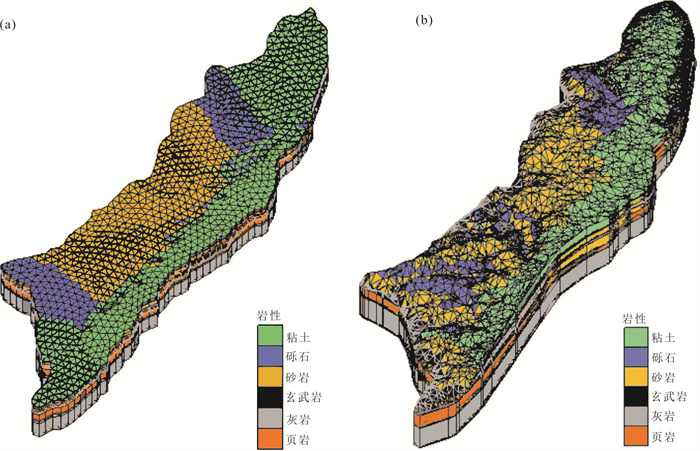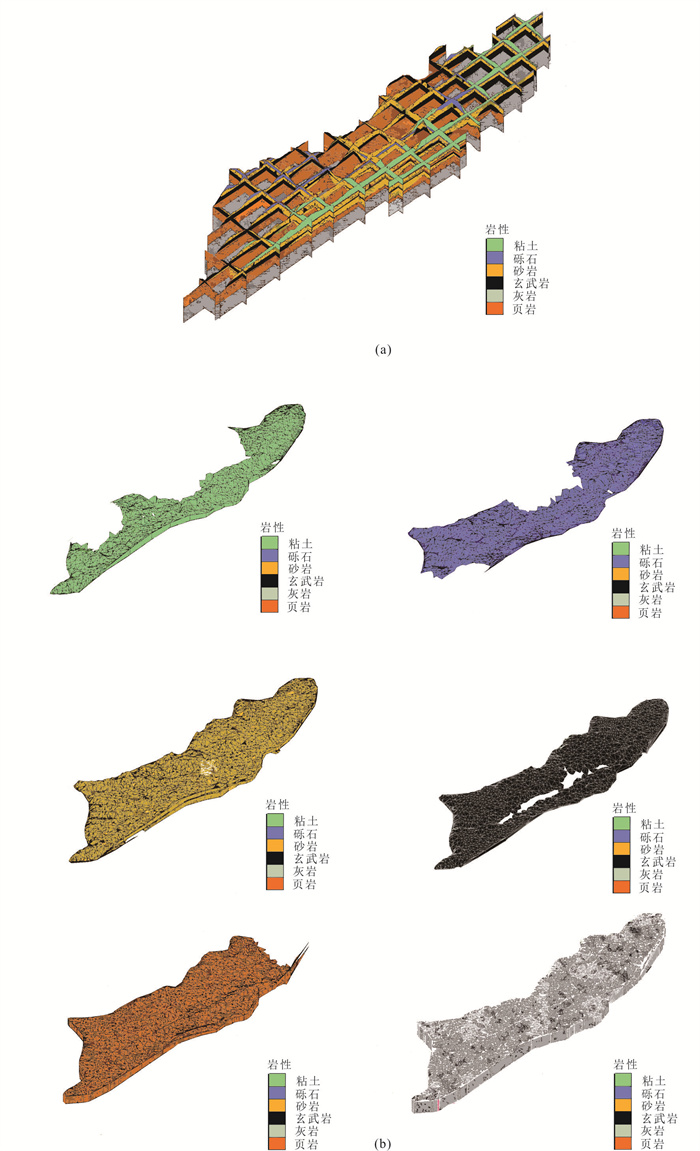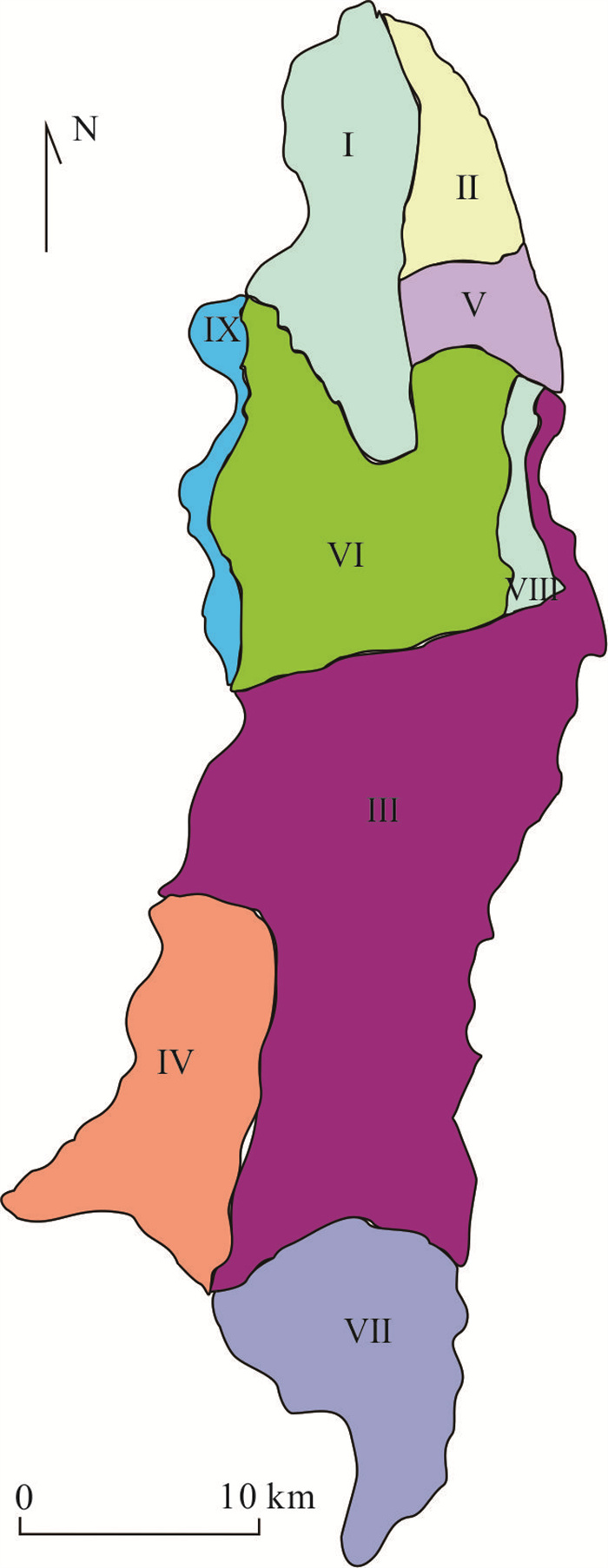Geothermal Resources Evaluation Based on 3D Geological Modeling: The Case of Shidian Geothermal Area
-
摘要: 传统热储法进行地热资源评价虽简便,但评价结果误差通常较大,本研究以施甸地热田为研究区,基于区内地质和地热地质条件,结合地球物理和钻孔资料,用GMS软件建立了三维地质模型,展示了研究区地热储层和盖层的展布情况.考虑到研究区内地热资源评价参数的差异,按照热储温度将研究区划分为9个子区,结合已建立的三维地质模型计算热储体积,利用改进的热储法来准确、动态评价研究区的地热资源量,计算出研究区地热水中储存的热量为1.38×1017 J,热储岩石中储存的热量为1.49×1019 J,地热资源总量为1.5×1019 J.根据地热水可开采量计算结果,若合理开发利用施甸地热水资源,每年可节约4.36×107 t标准煤.本研究为施甸地热资源的科学、合理评价提供了新的模式.Abstract: Although it is simple to evaluate geothermal resources using the traditional thermal reservoir method, the deviation of the evaluation results is usually large. Taking the Shidian geothermal field as a typical study area, a 3D geological model showing the distribution of geothermal reservoirs and caprocks in the area was built, using GMS software on the basis of geological and geothermal geological conditions in the region, combined with geophysical and drilling data. Considering the differences in the evaluation parameters of geothermal resources, the study area is divided into 9 sub-areas according to the thermal storage temperature, and the thermal reservoir volume is calculated in combination with the established three-dimensional geological model, and the improved thermal storage method is used to accurately and dynamically evaluate the study area. The heat stored in geothermal waters of the study area was calculated to be 1.38×1017 J, the heat stored in thermal storage rocks was 1.49×1019 J, and the total geothermal resources was 1.5×1019 J. According to the calculation results of the extractable amount of geothermal water, as well as the reasonable development and utilization of geothermal water resources in Shidian, 4.36×107 t of standard coal can be saved annually. This study provides a new mode for the scientific and rational evaluation of geothermal resources in Shidian.
-
Key words:
- 3D geological modeling /
- geothermal resource evaluation /
- GMS /
- Shidian /
- geothermal water resources
-
图 2 施甸盆地水热区典型剖面
1.砂、卵砾石层;2.粘土;3.白云质灰岩;4.玄武岩;5.地表水流向;6.地下水补给方向;7.物探推测断层及编号;8.钻孔:由上至下分别为编号、标高及水深埋深(m);改自云南地质工程第二勘察院地热队,2014,保山市施甸县地热资源调查及开发利用评价报告;剖面位置见图 1
Fig. 2. Typical profile of the hydrothermal zone in the Sidian basin
表 1 研究区分区面积及地热水统计
Table 1. Area of the study area and geothermal water statistics
分区 编号 模型坐标 热储温度(℃) 分区面积(km2) 面积占比(%) Ⅰ SDW065 X: 2735313; Y: 0509075 26 75.78 10.65 SDW008 X: 2741801; Y: 0509746 27 Ⅱ SDW009 X: 2744113; Y: 0515445 37 30.27 4.25 Ⅲ SDW013 X: 2719795; Y: 0504821 49 270.97 38.07 SDW012 X: 2732412; Y: 0518146 50 Ⅳ SDW014 X: 2700122; Y: 0502594 59 80.60 11.32 Ⅴ SDZK003 X: 2735400; Y: 0518725 71 24.46 3.44 Ⅵ SDW007 X: 2735329; Y: 0507385 78 122.91 17.27 Ⅶ SDW015 X: 2698723; Y: 0508034 103 78.77 11.07 Ⅷ SDW011 X: 2732856; Y: 0517539 109 11.38 1.60 Ⅸ SDW006 X: 2735782; Y: 0506389 118 16.61 2.33 表 2 研究区各分区热储体积
Table 2. Volume of thermal storage in each partition of the study area
分区 热储体积(109km3) 体积占比(%) Ⅰ 13.16 9.54 Ⅱ 7.08 5.13 Ⅲ 56.94 41.26 Ⅳ 12.60 9.13 Ⅴ 5.68 4.12 Ⅵ 22.27 16.14 Ⅶ 15.33 11.11 Ⅷ 2.94 2.13 Ⅸ 1.99 1.44 表 3 地热储量热储法计算结果
Table 3. Calculation results of the thermal storage method for geothermal reserves
分区 tr(均值) t0 QL
(107m3)QW (1015J) Qr (1017J) Q (1017J) Ⅰ 26.5 17.8 6.52 2.37 2.84 2.86 Ⅱ 37 2.88 2.31 3.37 3.39 Ⅲ 49.5 24.80 32.86 44.77 45.09 Ⅳ 59 6.73 11.58 12.87 12.99 Ⅴ 71 2.32 5.16 7.50 7.55 Ⅵ 78 10.72 26.96 33.25 33.52 Ⅶ 103 7.03 25.02 32.40 32.65 Ⅷ 109 1.12 4.28 6.65 6.69 Ⅸ 118 1.29 5.42 4.94 4.99 总计 63.40 138.12 148.59 149.75 表 4 研究区地热规模
Table 4. Size of geothermal area in study area
分区 编号 热储温度 可开采量(L/s) 热功率(kW) 研究区 开采100 a热能(109MJ) 占热储热量(%) 规模 Ⅰ SDW065 26 63.91 2194.14 69.24 25.55 小型 SDW008 27 3.24 124.80 3.94 Ⅱ SDW009 37 0.81 65.11 2.05 0.61 小型 Ⅲ SDW013 49 0.87 113.65 3.59 0.98 小型 SDW012 50 9.54 1286.13 40.59 Ⅳ SDW014 59 4.60 793.48 25.04 1.93 小型 Ⅴ SDZK003 71 33.57 7477.31 235.96 31.24 小型 Ⅵ SDW007 78 12.02 3029.59 95.60 2.85 小型 Ⅶ SDW015 103 9.20 3281.78 103.56 3.17 小型 Ⅷ SDW011 109 13.82 5276.98 166.52 24.89 小型 Ⅸ SDW006 118 1.52 637.25 20.11 4.03 小型 合计 153.10 2.43×104 766.20 表 5 研究区1 a可利用的地热能及对应节煤量
Table 5. Geothermal energy available in the study area for 1 a and the corresponding coal savings
分区 编号 热功率(kW) 开采一年可利用的热能(MJ) 相当于标准煤(t) Ⅰ SDW065 2 194.14 1.15×108 3.94×106 SDW008 124.80 6.56×106 2.24×105 Ⅱ SDW009 65.11 3.42×106 1.17×105 Ⅲ SDW013 113.65 5.98×106 2.04×105 SDW012 1 286.13 6.76×107 2.31×106 Ⅳ SDW014 793.48 4.17×107 1.42×106 Ⅴ SDZK003 7 477.31 3.93×108 1.34×107 Ⅵ SDW007 3 029.59 1.59×108 5.44×106 Ⅶ SDW015 3 281.78 1.73×108 5.89×106 Ⅷ SDW011 5 276.98 2.78×108 9.47×106 Ⅸ SDW006 637.25 3.35×107 1.14×106 合计 2.43×104 1.28×109 4.36×107 -
Cai, Z. Z., 1992. Evaluation of Geothermal Resources in Huainan Coalfield. Coal Geology of China, 4(1): 53-58 (in Chinese with English abstract). Fan, S. K., Cui, H. M., Zhou, L. B., 2015. Forecasting the Mine Water Inflow and Analyzing the Impact on the Environment Based on the GMS. China Mining Magazine, 24(S2): 178-181 (in Chinese with English abstract). Fournier, R. O., 1979. Geochemical and Hydrologic Considerations and the Use of Enthalpy-Chloride Diagrams in the Prediction of Underground Conditions in Hot-Spring Systems. Journal of Volcanology and Geothermal Research, 5(1-2): 1-16. https://doi.org/10.1016/0377-0273(79)90029-5 He, T. Z., 2012. Assessment on Geothermal Energy Resources and Geothermal Water Storage in Xiaotangshan Geothermal Field. Urban Geology, 7(4): 20-23, 31 (in Chinese with English abstract). He, Y., 2022. Geothermal Resource Status Quo and Resource Potential Assessment in Taihu Lake South Bank Area. Coal Geology of China, 34(1): 75-80 (in Chinese with English abstract). He, Y. J., Ding, X., 2020. Calculation of Geothermal Resources Based on Parameter Identification: A Case Study from the Western Slope of the Yinchuan Plain. Acta Geologica Sinica, 94(7): 2131-2138 (in Chinese with English abstract). doi: 10.3969/j.issn.0001-5717.2020.07.021 Huang, X. Y., 2011. Measurement Application of GMS Software in Three-Dimensional Geological Modeling. Advanced Measurement and Laboratory Management, 19(4): 10-12 (in Chinese). Lautz, L. K., Siegel, D. I., 2006. Modeling Surface and Ground Water Mixing in the Hyporheic Zone Using MODFLOW and MT3D. Advances in Water Resources, 29(11): 1618-1633. https://doi.org/10.1016/j.advwatres.2005.12.003 Lee, Y., Park, S., Kim, J., et al., 2010. Geothermal Resource Assessment in Korea. Renewable and Sustainable Energy Reviews, 14(8): 2392-2400. https://doi.org/10.1016/j.rser.2010.05.003 Li, J. X., 2019. Study on the Key Factors of Geothermomenters and Their Application: A Case Study of Crystalline Basement Reservoirs (Dissertation). China University of Geosciences, Wuhan (in Chinese with English abstract). Liu, J. Q., 2014. Estimation of Thermal Storage Temperature by Geothermal Thermometer: Taking Chongren Hot Water in Shengzhou as an Example. West-China Exploration Engineering, 26(5): 129-132 (in Chinese with English abstract). doi: 10.3969/j.issn.1004-5716.2014.05.043 Liu, M. L., He, T., Wu, Q. F., et al., 2020. Hydrogeochemistry of Geothermal Waters from Xiongan New Area and Its. Earth Science, 45(6): 2221-2231 (in Chinese with English abstract). Liu, X. M., 1986. Preliminary Evaluation of Geothermal Resources in Xi'an Area. Ground Water, 8(4): 52-54 (in Chinese with English abstract). Pang, Z. H., Huang, S. P., Hu, S. B., et al., 2014. Geothermal Studies in China: Progress and Prospects 1995-2014. Chinese Journal of Geology, 49(3): 719-727 (in Chinese with English abstract). Shen, Z. H., Xue, L., Han, L., et al., 2020. Calculation and Evaluation of Geothermal Resources in Zhangqiu Geothermal Field. Shandong Land and Resources, 36(4): 31-37 (in Chinese with English abstract). Shi, L., 2004. Study of the Tectonic-Thermal Evolution of the Songliao Basin and Quantitative Assessment of Its Geothermal Resource: A Case Study on the Dumeng District (Dissertation). Guangzhou Institute of Geochemistry, Chinese Academy of Sciences, Guangzhou (in Chinese with English abstract). Wang, J. X., 2014. Evaluation on Geothermal Resource of Xinzhou Qicun (Dissertation). China University of Geosciences, Beijing (in Chinese with English abstract). Wang, Y. J., 2014. Reserves Evaluation of Geothermal Resource in Yinchuan Plain Based on 3D Geological Modeling (Dissertation). China University of Geosciences, Beijing (in Chinese with English abstract). Zhan, Q., Cui, Y., 2010. Present Situation and Prospect Analysis of Geothermal Resources Development and Utilization in China. Theory Monthly, (8): 170-172 (in Chinese). Zhang, M. Z., Guo, Q. H., Liu, M. L., et al., 2023. Geochemical Characteristics and Formation Mechanism of Geothermal Water in Xinzhou Basin, Shanxi Province. Earth Science, 48(3): 973-987 (in Chinese with English abstract). Zhu, X., Zhang, Q. L., Liu, Y. G., 2016. Evaluation of the Geothermal Resources in the Plain of West Shandong Province. Geological Science and Technology Information, 35(4): 172-177 (in Chinese with English abstract). Zhu, Z. Z., Lei, X. D., Wu, X., et al., 2020. Geothermal Resource Evaluation in Changping New Town, Beijing: Perspective from 3D Geological Modeling. Geoscience, 34(1): 207-214 (in Chinese with English abstract). 蔡致中, 1992. 淮南煤田地热资源评价. 中国煤田地质, 4(1): 53-58. https://www.cnki.com.cn/Article/CJFDTOTAL-ZGMT199201012.htm 范书凯, 崔海明, 周连碧, 2015. 基于GMS的矿坑涌水量预测与环境影响分析. 中国矿业, 24(S2): 178-181. https://www.cnki.com.cn/Article/CJFDTOTAL-ZGKA2015S2044.htm 何铁柱, 2012. 北京小汤山地热田地热资源量及地热水储存量计算与评价. 城市地质, 7(4): 20-23, 31. https://www.cnki.com.cn/Article/CJFDTOTAL-CSDZ201204005.htm 何钰, 2022. 太湖南岸地热资源现状及资源潜力评价. 中国煤炭地质, 34(1): 75-80. https://www.cnki.com.cn/Article/CJFDTOTAL-ZGMT202201013.htm 何雨江, 丁祥, 2020. 基于参数辨识的典型区地热资源量研究: 以银川平原西部斜坡区为例. 地质学报, 94(7): 2131-2138. https://www.cnki.com.cn/Article/CJFDTOTAL-DZXE202007021.htm 黄新迎, 2011. GMS软件在三维地质建模的测量应用. 现代测量与实验室管理, 19(4): 10-12. https://www.cnki.com.cn/Article/CJFDTOTAL-XDJL201104005.htm 李洁祥, 2019. 水化学地热温度计的主控因素及其应用研究: 以结晶岩类热储为例(博士学位论文). 武汉: 中国地质大学. 刘军强, 2014. 应用地热温标估算热储温度: 以嵊州崇仁热水为例. 西部探矿工程, 26(5): 129-132. https://www.cnki.com.cn/Article/CJFDTOTAL-XBTK201405043.htm 刘明亮, 何曈, 吴启帆, 等, 2020. 雄安新区地热水化学特征及其指示意义. 地球科学, 45(6): 2221-2231. doi: 10.3799/dqkx.2019.270 刘肖梅, 1986. 西安地区地热资源的初步评价. 地下水, 8(4): 52-54. https://www.cnki.com.cn/Article/CJFDTOTAL-DXSU198604029.htm 庞忠和, 黄少鹏, 胡圣标, 等, 2014. 中国地热研究的进展与展望(1995-2014). 地质科学, 49(3): 719-727. https://www.cnki.com.cn/Article/CJFDTOTAL-DZKX201403002.htm 申中华, 薛磊, 韩琳, 等, 2020. 章丘地热田地热资源量计算与评价. 山东国土资源, 36(4): 31-37. https://www.cnki.com.cn/Article/CJFDTOTAL-SDDI202004005.htm 施龙, 2004. 松辽盆地构造热演化及地热资源定量评价研究: 以杜蒙地区为例(博士学位论文). 广州: 中国科学院广州地球化学研究所. 王俊鑫, 2014. 忻州市奇村地热资源评价(硕士学位论文). 北京: 中国地质大学. 王亚军, 2014. 基于三维地质建模的银川平原地热资源储量评价(硕士学位论文). 北京: 中国地质大学. 詹麒, 崔宇, 2010. 我国地热资源开发利用现状与前景分析. 理论月刊, (8): 170-172. https://www.cnki.com.cn/Article/CJFDTOTAL-LLYK201008046.htm 张梦昭, 郭清海, 刘明亮, 等, 2023. 山西忻州盆地地热水地球化学特征及其成因机制. 地球科学, 48(3): 973-987. 朱喜, 张庆莲, 刘彦广, 2016. 基于热储法的鲁西平原地热资源评价. 地质科技情报, 35(4): 172-177. https://www.cnki.com.cn/Article/CJFDTOTAL-DZKQ201604027.htm 朱振洲, 雷晓东, 武雄, 等, 2020. 基于三维地质建模的北京市昌平新城地热资源量评价. 现代地质, 34(1): 207-214. https://www.cnki.com.cn/Article/CJFDTOTAL-XDDZ202001020.htm -









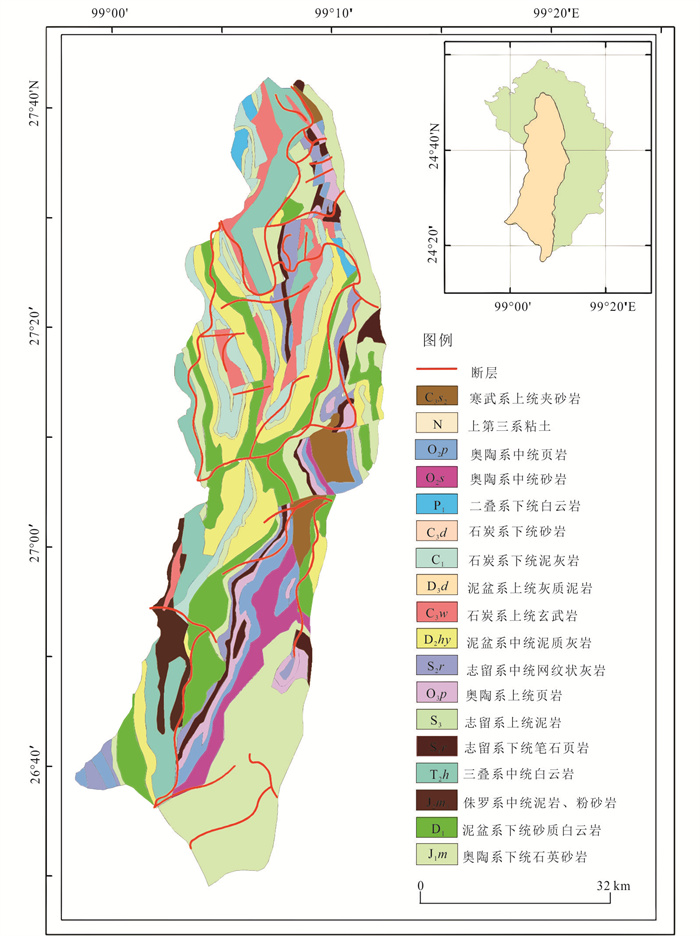
 下载:
下载:
